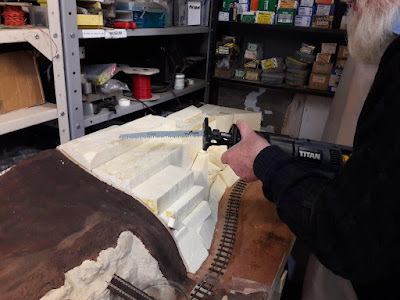Worklist:
Have a running session.
Establish positions of the uncoupling magnets for train movements in and out of the mason's yard.
Un-planned worklist:
Unstick all three points where the track had been painted.
Resolve the short circuit in the mason's yard.
The previous week we decided that we'd have a full running session this week using the whole layout. All of the boards were set up. At Laurence's request, the initial part of the session was given over to a recap of the exchange push-button system worked and the three sections on the 'local' control panel sections. It has been a long time since we'd worked on the new boards and the recap welcome. However, it was made more difficult, as there was no track plan on the panel - yet!
The first problem on the new boards was that the points were stuck fast with rail paint, which Stephen had to scrape away. All then went well until Laurence tried to run a loco into the stone mason's yard and a short circuit was discovered. We spent a long time narrowing the actual problem down, but finally decided that the short must be in one of the copper-clad sleepers fitted to allow the roadway check rails to be soldered in place. Geoff decided to burn-out the thread of copper with a dodgy looking capacitor contraption, but this failed. Stephen started to excavate the plaster infill between the check rails at one end, while Geoff ran a cutting disk down the centre of the track from the other end. In no time, the problem was found - an incomplete sleeper gap. The plaster will be reinstated in due course.
Magnets: Some basic train movements were established.
Trains dropping slabs/blocks off would only be coming from Worton Court and would require a pilot loco for shunting from the rear end. (This will be housed at the adjacent engine shed).
Empty slab/block wagons would go from the yard back up to the quarry using a light loco or be picked up by a train heading to Worton Court.
Outgoing finished stone goods wagons would be added to trains from Worton Court and would require the pilot. Those wagons returning from the mainline transfer yard would be dropped off by trains running back to Worton Court or the quarry, by the loco. They would then be shunted in the yard by the pilot loco.
We were then able to run a train and decide where magnets would best be placed. We were pleased to find they worked well with the established track breaks. Unlike previous magnets, these would be mounted on servo-driven plates that would lower and raise the magnets as required. These will be controlled by spare capacity on the Merg point control board already fitted, although additional loom wiring will be needed.
We didn't get to do much else, but it was a very interesting day. We will continue the running session next week.
 |
| Not much room in the middle. |
 |
| The capacitor 'blasting' device. |
 |
| The checkrail copper sleepers being unearthed. |


































